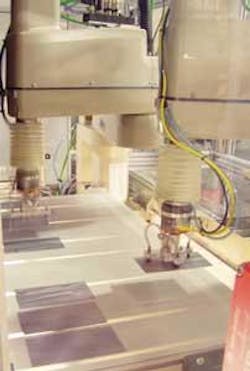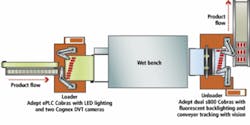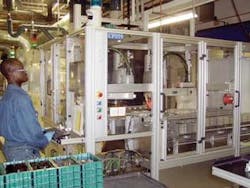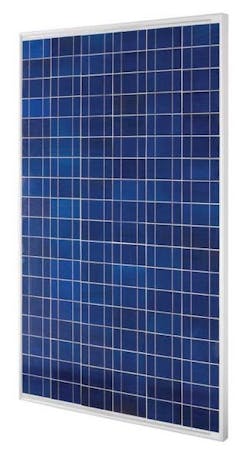Into the Light
Vision-guided robotic systems inspect and package solar cell wafers
Joyce Laird, Contributing Editor
Evergreen Solar produces solar panels using its proprietary crystalline silicon technology known as String Ribbon. To manufacture the wafers that form the basis for the panels of solar cells, parallel wires or strings are pulled through a silicon melt and the molten silicon spans and solidifies between the strings, creating a long ribbon that is periodically harvested for processing into solar cells. This unusual method of developing solar cells has proved to be simple, efficient, and commercially successful.
Success has required greater processing speed to meet demand. The original gantry fixed automation system developed in-house to handle the inspection, sorting, and packing steps was becoming too costly to maintain and required five pickup steps to move the pre-etched silicon wafers to their final destination after they had been acid-etched to clean the surfaces.
Peter Kane, principal engineer at Evergreen, says that the less the wafers are handled the better. “We decided that going to a robotic system could bring this handling down to only two steps. We selected Adept robots and built a system around the robots’ capabilities.”
The plan encompassed two separate applications: front and back end, each requiring their own specific process steps. Kane was responsible for the design and construction of the overall system, including automation of the cell area. Glenn Bohling, also a principal engineer, was responsible for the controls and software development.
Kane designed a system that would handle both sides of the process. On the front end, two robots pick up wafers for inspection, sorting, and loading onto a conveyor, and on the back end two robots unload the wafers from the conveyor and put them into boxes. Solar cell wafers require precise handling and final inspection for a variety of faults before they are ready for further processing.
“We designed everything for the system we wanted in-house,” Kane says. “There were two types of vision integration needed. The back-end machine had to pick the wafers up off of a moving belt and Adept offered a well integrated vision and motion package.”
The robotic system uses the Adept Cobra s800, a SCARA-type robot, and includes the Adept SmartServo controls architecture that supports options such as conveyor tracking and vision-guided motion. The diagnostics display enables troubleshooting, and the robot has integrated temperature sensors to monitor heat in servo motors to prevent damage.
System design
On the front end, the system is required to pick wafers out of boxes and move them to a camera station to inspect the wafers for imperfections such as cosmetic defects, edge defects, and cracks. It also needed to determine x-y and theta position of the wafers when placing them on the conveyor (see Fig. 1).
“We use the ePLC version of the 800 robot for this,” Kane says. “An Allen Bradley PLC controls each robot and it also talks to the vision system. We use two Cognex DVT 540 smart cameras, which include a processor, image sensor, the optics, and light.”
The Adept ePLC Connect Server software provides connectivity with the PLC. All application programs and locations are defined and reside within the Allen Bradley PLC. The PLC client retrieves this data and commands the robot to move.
The robot lifts an individual wafer from a box, moves it over the camera, which is located below the conveyor; LED lights on the robot provide additional backlighting for the camera. The wafers are visually inspected; rejects are set aside. The software records the processing data for statistical process control (SPC) recall and evaluation. Reasons for rejects are noted. If they pass inspection, wafers are placed on the conveyor to be moved through the acid wet bench (see Fig. 2).
Kane says that Evergreen has used the DVT cameras for many other machine-vision applications within the plant, so the company is familiar with the benefits of these smart cameras. The Cognex DVT system uses a Hitachi SH4 processor and has 64 Mbytes of RAM and 16 Mbytes of flash memory. The CCD camera operates at 75 frames/s and supports partial frame acquisition.
The smart camera communicates through Ethernet and RS-232. Vision tool support includes identification (modeling), readers (ID, 2-D, OCR/OCV), flaw detection, and application-specific scripting. The camera can analyze for odd shapes and inspect for multiple and overlapping parts in a range of light conditions, which means it is suitable for robotic guidance.
“We use the Allen Bradley ControlLogix PLC platform and DVT vision with standard lenses; there is nothing really proprietary here,” Bohling says. “We use a state diagram system. All the PLC programming is based on state diagrams, which detail the logic flow of the machine sequences.”
“We use custom Visual Basic operator interface applications,” he adds. “We developed these in-house. It’s standard on all of our machines so that any operator can go to any machine in the plant and know how to use it.” (See Fig. 3).
null
Front and back
On the out-feed end, a Dorner conveyor was used, incorporating simple fluorescent backlighting. The wafers pass over a backlit area so the out-feed robots’ integrated vision systems can capture a binary image of a black wafer against a white background, inspecting for cracks and chips.
The unloader is a fully equipped Adept Cobra dual s800, which uses a single controller to control both robots with sAVI Vision and conveyor tracking. It coordinates robotic movement with wafers being presented on a moving conveyor (see Fig. 4). Each unloader robot incorporates an RS-170 camera to inspect the wafers. Any wafer that fails is not picked up and instead drops off the end of the conveyor into a reject bin.
The entire robotic integrated system for loading/inspection and unloading/packing was built at the Evergreen plant offline. It took one day to dismantle and move the old gantry system out and install the new system.
Evergreen currently has 10 Adept robot systems running at its plant in Marlborough, MA. The downtime for maintenance has been essentially eliminated in comparison to the old gantry-based automation system that was down for maintenance at least once a week. The conveyors, PLC controllers, and cameras had all been in use on other systems within the plant, and proved robust and reliable when integrated with the robots.
features, advantages, benefits
“We use the packaged system: AdeptVision sAVI vision, conveyor tracking, and the robot all integrated,” says Peter Kane, principal engineer at Evergreen Solar. “We did that because they offer an off-the-shelf system specifically for this type of application. Since all the engineering was basically done, it made a lot of sense to use a vision system designed for picking parts off of a moving conveyor.”
He adds, “The conveyor tracking side would have been very difficult for us to do from scratch and would have required a huge amount of development work. Installing the system after it was assembled was the easiest part of the process. We increased our solar cell yield about 1% because of less wafer breakage and greatly increased uptime.”
Company Info
Adept Technology
Livermore, CA, USA
www.adept.com
Cognex, Natick, MA, USA
www.cognex.com
Dorner Manufacturing
Hartland, WI, USA
www.dornerconveyors.com
Evergreen Solar
Marlborough, MA, USA
www.evergreensolar.com
Rockwell Automation
Allen Bradley Control Systems
Milwaukee, WI, USA
www.ab.com





